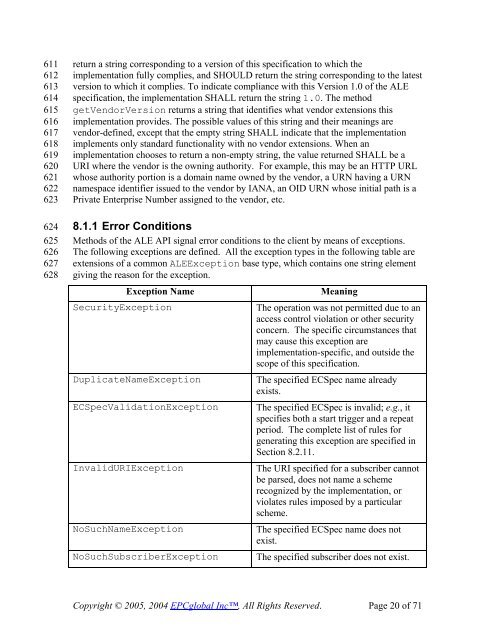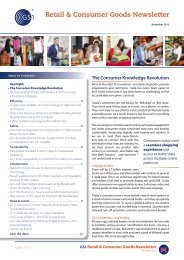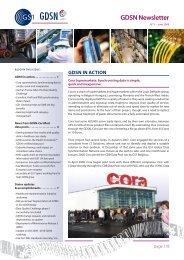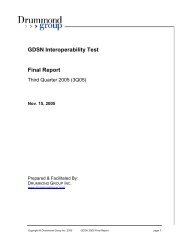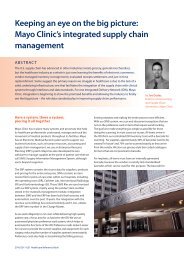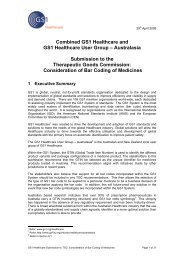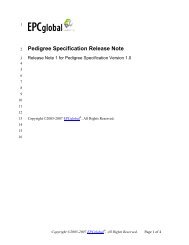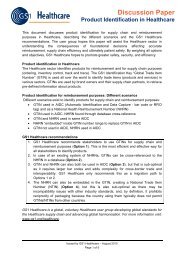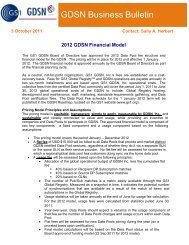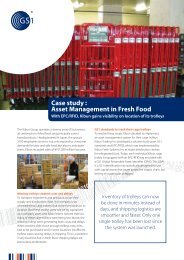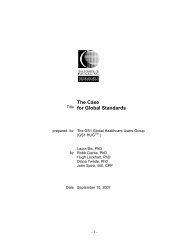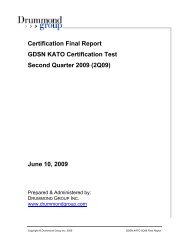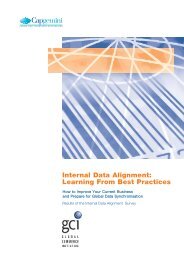The Application Level Events (ALE) Specification, Version 1.0 - GS1
The Application Level Events (ALE) Specification, Version 1.0 - GS1
The Application Level Events (ALE) Specification, Version 1.0 - GS1
Create successful ePaper yourself
Turn your PDF publications into a flip-book with our unique Google optimized e-Paper software.
611<br />
612<br />
613<br />
614<br />
615<br />
616<br />
617<br />
618<br />
619<br />
620<br />
621<br />
622<br />
623<br />
624<br />
625<br />
626<br />
627<br />
628<br />
return a string corresponding to a version of this specification to which the<br />
implementation fully complies, and SHOULD return the string corresponding to the latest<br />
version to which it complies. To indicate compliance with this <strong>Version</strong> <strong>1.0</strong> of the <strong>ALE</strong><br />
specification, the implementation SHALL return the string <strong>1.0</strong>. <strong>The</strong> method<br />
getVendor<strong>Version</strong> returns a string that identifies what vendor extensions this<br />
implementation provides. <strong>The</strong> possible values of this string and their meanings are<br />
vendor-defined, except that the empty string SHALL indicate that the implementation<br />
implements only standard functionality with no vendor extensions. When an<br />
implementation chooses to return a non-empty string, the value returned SHALL be a<br />
URI where the vendor is the owning authority. For example, this may be an HTTP URL<br />
whose authority portion is a domain name owned by the vendor, a URN having a URN<br />
namespace identifier issued to the vendor by IANA, an OID URN whose initial path is a<br />
Private Enterprise Number assigned to the vendor, etc.<br />
8.1.1 Error Conditions<br />
Methods of the <strong>ALE</strong> API signal error conditions to the client by means of exceptions.<br />
<strong>The</strong> following exceptions are defined. All the exception types in the following table are<br />
extensions of a common <strong>ALE</strong>Exception base type, which contains one string element<br />
giving the reason for the exception.<br />
Exception Name<br />
SecurityException<br />
DuplicateNameException<br />
ECSpecValidationException<br />
InvalidURIException<br />
NoSuchNameException<br />
NoSuchSubscriberException<br />
Meaning<br />
<strong>The</strong> operation was not permitted due to an<br />
access control violation or other security<br />
concern. <strong>The</strong> specific circumstances that<br />
may cause this exception are<br />
implementation-specific, and outside the<br />
scope of this specification.<br />
<strong>The</strong> specified ECSpec name already<br />
exists.<br />
<strong>The</strong> specified ECSpec is invalid; e.g., it<br />
specifies both a start trigger and a repeat<br />
period. <strong>The</strong> complete list of rules for<br />
generating this exception are specified in<br />
Section 8.2.11.<br />
<strong>The</strong> URI specified for a subscriber cannot<br />
be parsed, does not name a scheme<br />
recognized by the implementation, or<br />
violates rules imposed by a particular<br />
scheme.<br />
<strong>The</strong> specified ECSpec name does not<br />
exist.<br />
<strong>The</strong> specified subscriber does not exist.<br />
Copyright © 2005, 2004 EPCglobal Inc, All Rights Reserved. Page 20 of 71


